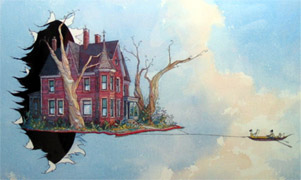
| School Information System |
 |
|
 | Newsletter signup | Send us your ideas
| Newsletter signup | Send us your ideas
February 8, 2014Monstrous (aka CC "deeper learning")[The Prentice Hall Common Core literature textbook for the tenth grade:]
According to the notes in the margins of the Teacher's Edition, they should begin by offering to the class "classic examples of urban myths, tales of alien abductions, or ghost stories. (Examples include stories of alligators in the sewers, a man abducted for his kidneys, and aliens landing in Roswell, New Mexico)." (The word "classic" is being used very loosely.) To reinforce the findings of this "brainstorming activity," students should also "write a paragraph based on one of these modern urban myths." The class will also discuss Mary Shelley's introduction in various ways. Helping out, Elizabeth McCracken offers several more "scholar's insights," including one informing us of another ghost story about a man who buried his murder victim at the base of a tree "only to find that the next year's apples all had a clot of blood at the center of them." On the following page, we learn that Elizabeth McCracken did read the book, which she found better than the movie because, she tells us, in the book the monster can actually talk. Teachers are prompted to ask students why they think the film version would choose to keep the monster silent. Since the class will not be diverted enough with all this talk of movies, the Teacher's Edition also recommends that talented and gifted students "illustrate one aspect of Shelley's imaginings that is especially Gothic in its mood" and "display their Gothic art to the rest of the class." Do the editors realize that all this extraneous discussion of monsters and ghosts only serves to preserve the silly Halloween caricature of Frankenstein? Apparently this caricature is what they want. On page 766, students are encouraged to "write a brief autobiography of a monster." The editors point out that monster stories are usually told from the perspective of "the humans confronting the monster." The editors of The British Tradition want to turn the tables and have students ask themselves "what monsters think about their treatment." Now there's a great exercise in multiculturalism! Those poor, misunderstood monsters. Thus, students are being asked to write a monster story. What good could come from this? Without reading the novel Frankenstein itself (which does in fact tell much of the story from the monster's perspective), students have no way of knowing how human this Gothic tale really is. After a mere three and a half pages of Mary Shelley's introduction, the book offers a series of questions under various headings: Critical Reading, Literary Analysis, and so forth. Some of these questions are steeped in two-bit literary criticism. Others require students to delve into the moral realms of science and creation. One is a question asking students to interpret a modern cartoon about Frankenstein--funny, but out of place in this literature book. Notwithstanding whether the questions are good or bad, the enterprise is as false as the worst Hollywood versions of Frankenstein. The questions offer the façade of learning without genuine learning having taken place. That is for a very simple reason. My wife, the former English teacher who recognizes pretense when she sees it, took one look at these pages and put it very simply: "They (the editors) are requiring students to have opinions on something they know nothing about." Moore, Terrence (2013-11-29). ------------------------- Subscribe to this site via RSS/Atom:  Newsletter signup | Send us your ideas Newsletter signup | Send us your ideas
Comments
Post a comment
|